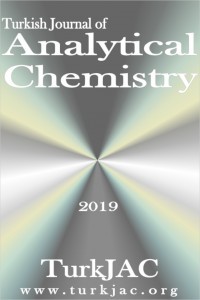The use of honey as a green solvent in the extraction of raw propolis
The use of honey as a green solvent in the extraction of raw propolis
Solvent, honey-water, propolis extract,
___
- [1] O. O. Erejuwa, S. A. Sulaiman, M. S. Ab Wahab, Honey: a novel antioxidant, Molecules, 17(4), 2012, 4400-4423. [2] J. M Alvarez-Suarez, F. Giampieri, M. Battino, Honey as a source of dietary antioxidants: structures, bioavailability, and evidence of protective effects against human chronic diseases, Curr Med Chem, 20(5), 2013, 621-638.
- [3] R. Cooper, Honey for wound care in the 21st century, J Wound Care, 25(9), 2016, 544-552.
- [4] K. Brudzynski, C. Sjaarda, Honey glycoproteins containing antimicrobial peptides, Jelleins of the Major Royal Jelly Protein 1, are responsible for the cell wall lytic and bactericidal activities of honey, Plos One, 10(4), 2015, e0120238.
- [5] V. Bankova, Chemical diversity of propolis and the problem of standardization, J Ethnopharmacol, 100(1-2), 2005, 114-117.
- [6] W. Krol, S. Scheller, J. Shani, G. Pietsz, Z. Czuba, Synergistic effect of ethanolic extract of propolis and antibiotics on the growth of staphylococcus aureus, Arznei-Forschung, 43(5), 1993, 607-609.
- [7] J. M. Sforcin, V. Bankova, Propolis: is there a potential for the development of new drugs?, J Ethnopharmacol, 133(2), 2011, 253-260.
- [8] V. Bankova, B. Trusheva, M. Popova, Propolis extraction methods: a review, J Apicult Res, 60:5, 2021, 734-743.
- [9] M. Jug, O. Karas, I. Kosalec, The influence of extraction parameters on antimicrobial activity of propolis extracts, Nat Prod Commun, 12(1), 2017, 1934578X1701200113
- [10] Y. Kara, Z. Can, S. Kolaylı, What should be the ideal solvent percentage and solvent-Propolis ratio in the preparation of Ethanolic Propolis extract?, Food Anal Method, , 15(6), 2022, 1707-1719.
- [11] B. Lawal, O. K. Shittu, A. N. Abubakar, I. A. Olalekan, A. M. Jimoh, A. K. Abdulazeez, Drug leads agents from methanol extract of Nigerian bee (Apis mellifera) propolis, J Intercultural Ethnopharmacol, 5(1), 2016, 43.
- [12] M. Sambou, J. Jean-François, F. J. Ndongou Moutombi, J. A. Doiron, M. P. Hébert, A. P. Joy, M. Touaibia, Extraction, antioxidant capacity, 5-lipoxygenase inhibition, and phytochemical composition of propolis from Eastern Canada, Molecules, 25(10), 2020, 2397.
- [13] A. S. Freitas, A. Cunha, P. Parpot, S. M. Cardoso, R. Oliveira, C. Almeida-Aguiar, Propolis efficacy: the quest for eco-friendly solvents, Molecules, 27(21), 2022, 7531.
- [14] S. Ma, H. Ma, Z. Pan, L. Luo, L. Weng, Antioxidant activities of propolis's extracts by different solvents in vitro, Journal of Chinese Institute of Food Science and Technology, 16(8), 2016, 53–58. [in Chinese] (abstract in English available at: https://www.researchgate.net/publication/308363945_Antioxidant_activities_of_propolis%27s_extracts_by_different_solvents_in_vitro, 11.05.2023)
- [15] K. Slinkard, V. L. Singleton, Total phenol analysis: automation and comparison with manual methods, Am J Enol Viticult, 28(1), 1977, 49-55.
- [16] L. R. Fukumoto, G. Mazza, Assessing antioxidant and prooxidant activities of phenolic compounds, J Agr Food Chem, 48(8), 2000, 3597-3604.
- [17] P. Molyneux, The use of the stable free radical diphenylpicrylhydrazyl (DPPH) for estimating antioxidant activity, Songklanakarin J. sci. technol, 26(2), 2004, 211-219.
- [18] I. F. Benzie, J. J. Strain, [2] Ferric reducing/antioxidant power assay: direct measure of total antioxidant activity of biological fluids and modified version for simultaneous measurement of total antioxidant power and ascorbic acid concentration. In Methods in enzymology, 299, 1999, 15-27.
- [19] Y. Kara, Z. Can, S. Kolaylı, Applicability of Phenolic Profile Analysis Method Developed with RP-HPLC-PDA to some Bee Product, Braz Arch Biol Techn, 65, 2022.
- [20] M. Stoia, A. Cotınghıu, F. Budın, S. Oancea, Total phenolics content of Romanian propolis and bee pollen, Victoria, 2, 2015, 20.
- [21] S. M. Cottica, A. C. Sawaya, M. N. Eberlin, S. L. Franco, L. M. Zeoula, J. V. Visentainer, Antioxidant activity and composition of propolis obtained by different methods of extraction, J Brazil Chem Soc, 22, 2011, 929-935.
- [22] Z. Can, O. Yildiz, H. Sahin, E. A. Turumtay, S. Silici, S. Kolayli, An investigation of Turkish honeys: their physico-chemical properties, antioxidant capacities and phenolic profiles, Food Chem, 180, 2015, 133-141.
- [23] C. S. Funari, A. T. Sutton, R. L. Carneiro, K. Fraige, A. J. Cavalheiro, V. da Silva Bolzani, R. D. Arrua, Natural deep eutectic solvents and aqueous solutions as an alternative extraction media for propolis, Food Res Int, 125, 2019, 108559.
- [24] L. Kubiliene, A. Jekabsone, M. Zilius, S. Trumbeckaite, D. Simanaviciute, R. Gerbutaviciene, D. Majiene, Comparison of aqueous, polyethylene glycol-aqueous and ethanolic propolis extracts: antioxidant and mitochondria modulating properties, BMC Complem Altern M, 18, 2018, 1-10.
- [25] A. K. Kuropatnicki, E. Szliszka, M. Kłósek, W. Król, The beginnings of modern research on propolis in Poland, Evid-Based Compl Alt, 2013.
- Yayın Aralığı: Yılda 2 Sayı
- Başlangıç: 2019
- Yayıncı: Miraç OCAK
Zehra CAN, Elif AYAZOGLU DEMİR, Zeynep AKAR, Yakup KARA, Betül GIDIK
The use of honey as a green solvent in the extraction of raw propolis
Electroanalytical characterization of chloroquinoline substituted redox-active phthalocyanines
Asiye NAS, Gülsev DİLBER, Zekeriya BIYIKLIOĞLU
Duygu ÖZDEŞ, Celal DURAN, Sengul Tugba OZEKEN, Özgün KALKIŞIM, Yener TOP
Kübra ÖZTÜRK, Çiğdem ER ÇALIŞKAN, Zehra AKINCI, Harun ÇİFTÇİ
Pınar ŞEN, Parisa BOLOURİ, Fikrettin ŞAHİN
Hüseyin ÖZCAN, Aslıhan DALMAZ, Mesut ÖZDİNÇER, Kübra ZENKİN, Sefa DURMUŞ
